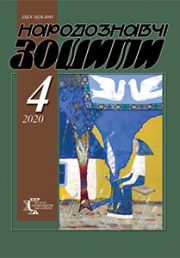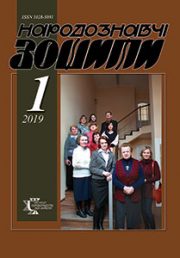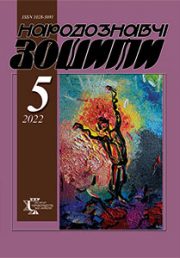The Ethnology Notebooks. 2018, 1 (139), 112–124
UDK 39:061.2(477.85/.87):902.2]”193»
DOI https://doi.org/10.15407/nz2018.01.112
Received 17.12.2017
ETHNOGRAPHIC EXPEDITIONS OF THE SOCIETY OF FRIENDS OF THE HUTSUL REGION
Patsai Tamara, candidate of sciences in history,
Senior Researcher,
Scientific secretary at the Institute of Ethnology
of the National Academy of Sciences of Ukraine,
Svobody Avenue 15, 79000, Lviv, Ukraine.
Contacts: e-mail: tamara.patsay@gmail.com
Abstract. The article is devoted to the research of the ethnographic expeditionary activity of the Society of Friends of the Hutsul Region, actively operated in the south-eastern territories of the Polish state in 1933—1939. The main focus is on the analysis of the activities of A. Fisher as the responsible head of scientific projects. The order of preparation of field research was reproduced, factors of influence on the choice of scientific topics, sources of project financing, key executors were determined.
Keywords: Society of Friends of the Hutsul Region, Adam Fisher, Jan Falkowski, ethnographic expedition.
REFERENCES
DAIFO. F. 370. Op. 1. Spr. 26.
DAIFO. F. 370. Op. 1. Spr. 30.
Derzhavnyj arkhiv L’vivs’koi oblasti (DALO). F. 26. Op. 7. Spr. 1547.
Archiwum Naukowe Polskiego Towarzystwa Ludoznawczego (AN PTL). Sygn. 348.
AN PTL. Sygn. 499.
AN PTL. Sygn. 500.
AN PTL. Sygn. 504.
AN PTL. Sygn. 507.
AN PTL. Sygn. 541.
Kyrchiv, R.F. (1978). Etnohrafichne doslidzhennia Bojkivschyny. Kyiv: Naukova dumka.
Kyrchiv, R. (2011). Ukrains’ka tema v narodoznavchij paradyhmi Adama Fishera. Narodoznavchi zoshyty. №. 4. Pp. 561–575.
Komar, V.L. (2011). Kontseptsiia prometeizmu v politytsi Pol’schi (1921–1939 rr.). Ivano-Frankivs’k : Misto NV.
Tarnavs’kyj, R. (2016). Kafedra etnolohii L’vivs’koho universytetu. Klasychnyj period (1910–1947). L’viv: LNU imeni Ivana Franka.
Fedorchak, P. (Ed.). (1996). Ukrains’ko-pol’s’ki vidnosyny v Halychyni u XX st. Ivano-Frankivs’k: Plaj.
Shvahuliak, M. (1994). Malovidoma storinka politychnoho zhyttia Zakhidnoi Ukrainy peredodnia Druhoi svitovoi vijny (3 istorii Kontaktnoho Komitetu. 1937–1939 roky). Zapysky Naukovoho tovarystva imeni Shevchenka. T. CCXXVIII. L’viv, pp. 207–248.
Shvahuliak, M.M. (1993). Patsyfikatsiia: pol’s’ka represyvna aktsiia u Halychyni 1930 r. i ukrains’ka suspil’nist’. L’viv.
Chudziński, E. (2013). Regionalizm: idea – ludzie – instytucje. Warszawa.
Dabrowski, P. (2014). Multiculturalism Polish style. Glimpses from the Interwar Period. Understanding multiculturalism: Central Europe and the Habsburg experience. New York; Oxford: Berghahn Books, pp. 85–100.
Engelking, A., Linkiewicz, O. (2010). Jan Kanty Falkowski (1901– ca. 1940). Etnografowie i ludoznawcy polscy. Sylwetki, szkice biografi czne. Wrocіaw; Krakуw. T. III. S. 61–72.
Falkowski, J. (1938). Etnografia gorali srodkowych i wschodnich Karpat Polskich. Warszawa.
Falkowski, J. (1938). Północno-wschodnie pogranicze Huculszczyzny. Lwów : Nakładem Towarzystwa Ludoznawczego.
Falkowski, J. (1937). Zachodnie pogranicze Huculszczyzny dolinami Prutu, Bystrzycy Nadwórniańskiej, Bystrzycy Sołotwińskiej i Łomnicy. Lwow: Nakl. Towarzystwa Ludoznawczego.
Falkowski, J. (1936). Ze wschodniego pogranicza huculskiego. Lud. Lwow. T. XXXIV. S. 142–156.
Falkowski, J., Pasznycki, B. (1935). Na pograniczu іemkowsko-bojkowskiem: Zarys etnograficzny. Lwow: Nakl. Towarzystwa Ludoznawczego.
Fischer, A. (1939). Zarys etnografii Polski Południowo-Wschodniej. Lwow.
Harasymczuk, R.-W. (1939). Tańce huculskie. Lwow: Nakl. Towarzystwa Ludoznawczego.
Harasymczuk, R.-W., Tabor, W. (1938). Etnografia poіonin huculskich. Lwow: Nakl. Towarzystwa Ludoznawczego.
Kacprzak, M. (2005). Towarzystwo Rozwoju Ziem Wschodnich 1933–1939.
Kacprzak, M. (2009). Ziemia dla їoіnierzy. Problem pozyskania i rozdysponowania gruntуw na cele osadnictwa wojskowego na Kresach Wschodnich 1920–1939.
Kaplon, J. (2012). Poznanie turystyczne Czarnohory. Karpaty: liudyna, etnos, tsyvilizatsiia. Vyp. 4. Pp. 263–280.
Kozlowska, A. (2014). Festiwale polskiego regionalizmu gуrskiego – święta, zjazdy i tygodnie gór (1935–1939). Zeszyty wiejskie (№ 19). Łódź. S. 279–295.
Kronika. Zloty szlak. 1938. R. 1. Z. 1. S. 76–77.
Linkiewicz, O. (2016). Scientific ideals and political engagement: polish ethnology and the ‘ethnic question’ between the wars. Acta Poloniae Historica. № 114. S. 5–27.
Quirini-Popіawski, Ј. (2008). Muzeum Huculskie w Żabiem. Pіaj 36 Almanach karpacki, pуіrocznik Towarzystwa Karpackiego. S. 110–131.
Statut Towarzystwa Przyjaciуі Huculszczyzny. Warszawa, 1934.
Udziela, S. (1934). Ziemia Јemkowska przed pуіwieczem: Zapiski i wspomnienia z lat 1888–1893. Lwow: Nakі. Towarzystwa Ludoznawczego.
Walne zebranie Tow. Przyjaciуі Huculszczyzny. Gazeta Lwowska. 1934. № 31. (3 lutego 1934).
Walne zebranie Tow. Przyjaciуі Huculszczyzny. Kurjer powszechny. 1934. № 32. (3 lutego 1934).
Wysocki, A. (2009). Regionalizm funkcjonalny w dziaіaniu (na Huculszczyџnie) w świetle e dokumentów Centralnego Archiwum Wojskowego. Rocznik archiwalno-historychny Centralnego Archiwum Wojskowego. Warszawa. № 2/31. S. 74–103.
Kaluski, M. Polskie dzieje Huculszczyzny. GI Kworum. URL: http://www.kworum.com.pl/art4395, polskie_dzieje_huculszczyzny.html.
Kaplon, J. (2012). Piкkno utraconej ojczyzny, folklor i tradycje. Dziennik Polski. URL: http://www.dziennikpolski24.pl/artykul/3107630,piekno-utraconej-ojczyzny-folklor-i-tradycje,1,id,t,sa.html.







